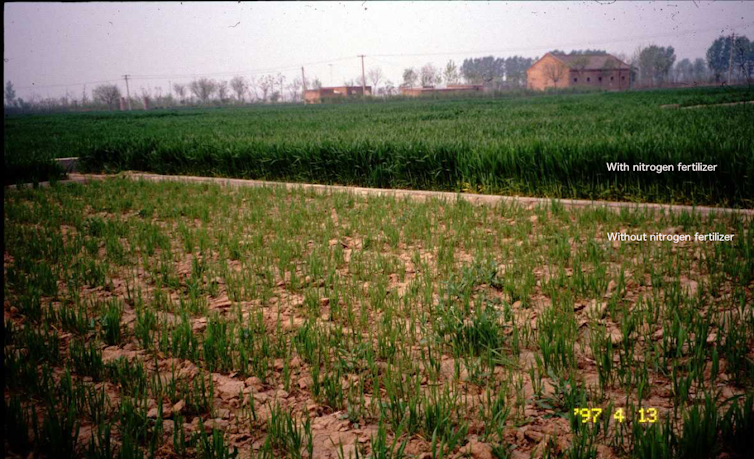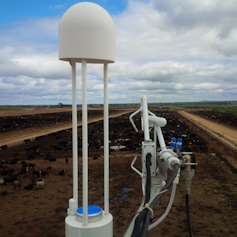While carbon pollution gets all the headlines for its role in climate change, nitrogen pollution is arguably a more challenging problem. Somehow we need to grow more food to feed an expanding population while minimising the problems associated with nitrogen fertiliser use.
In Europe alone, the environmental and human health costs of nitrogen pollution are estimated to be €70-320 billion per year.
Nitrogen emissions such as ammonia, nitrogen oxide and nitrous oxides contribute to particulate matter and acid rain. These cause respiratory problems and cancers for people and damage to forests and buildings.
Nitrogenous gases also play an important role in global climate change. Nitrous oxide is a particularly potent greenhouse gas as it is over 300 times more effective at trapping heat in the atmosphere than carbon dioxide.
Nitrogen from fertiliser, effluent from livestock and human sewage boost the growth of algae and cause water pollution. The estimated A$8.2 billion damage bill to the Great Barrier Reef is a reminder that our choices on land have big impacts on land, water and the air downstream.
Lost nitrogen harms farmers too, as it represents reduced potential crop growth or wasted fertiliser. This impact is most acute for smallholder farmers in developing countries, for whom nitrogen fertiliser is often the biggest cost of farming. The reduced production from the lost nitrogen can represent as much as 25% of the household income.
The solution to the nitrogen challenge will need to come from a combination of technological innovation, policy and consumer action.
The essential ingredient
Nitrogen is an essential building block for amino acids, proteins and DNA. Plant growth depends on it; animals and people get it from eating plants or other animals.
Nitrogen gas (N₂) makes up 78% of the air, but it cannot be used by plants. Fertilisers are usually made from ammonia, a form of nitrogen that the plants prefer.
A century after the development of the Haber-Bosch process gave us a way to manufacture nitrogen fertiliser, our demand for it has yet to level off.
The use of nitrogen fertiliser has risen from 11 million tonnes in 1961 to 108 million tonnes in 2014. As carbon dioxide levels continue to rise in the atmosphere, some plants such as grains will also likely demand more nitrogen.

In fact, nitrogen from fertiliser now accounts for more than half the protein in the human diet. Yet some 50% of applied nitrogen is lost to the environment in water run-off from fields, animal waste and gas emissions from soil microbe metabolism.
These losses have been increasing over the decades as nitrogen fertiliser use increases. Reactive nitrogen causes wide-ranging damage, and will cause more damage if nitrogen losses are not reined in.
Faced with a growing population and changing climate, we need more than ever to optimise the use of nitrogen and minimise the losses.
From farm to fork
One way to understand our nitrogen use is to look at our nitrogen footprint – the amount of nitrogen pollution released to the environment from food, housing, transportation and goods and services.
Research by University of Melbourne PhD candidate Emma Liang shows Australia has a large nitrogen footprint. At 47kg of nitrogen per person each year, Australia is far ahead of the US, which came in with 28kg of nitrogen per person.
A high-animal-protein diet appears to be driving Australia’s big nitrogen footprint. The consumption of animal products accounts for 82% of the Australian food nitrogen footprint.
Animal products carry high nitrogen costs compared to vegetable products. Both products start with the same cost in nitrogen as a result of growing a crop, but significant further losses occur as the animal consumes food throughout its life cycle.
The N-Footprint project aims to help individuals and institutions calculate their nitrogen footprints. It shows how we can each have an impact on nitrogen pollution through our everyday choices.
We can choose to eat lower nitrogen footprint protein diets, such as vegetables, chicken and seafood instead of beef and lamb. We can choose to reduce food waste by buying smaller quantities (and more frequently if necessary) and composting food waste. The good news is, if we reduce our nitrogen footprint, we also reduce our carbon footprint.
Back to the farm
In the meantime, efforts to use nitrogen more efficiently on farms must continue. We are getting better at understanding nitrogen losses from soil through micrometerological techniques.
From sitting in the sun with plastic bucket chambers, glass vials and syringes, scientists now use tall towers and lasers to detect small changes in gas concentrations over large areas and send the results directly to our computers.

We now know nitrification (when ammonia is converted to nitrate) is an important contributor to nitrogen losses and therefore climate change and damage to ecosystems. It is a process researchers – and farmers – are targeting to reduce nitrogen losses.
Nitrification inhibitors are now used commercially to keep nitrogen in the ammonium form, which plants prefer, and to prevent the accumulation of nitrate, which is more easily lost to the environment.
As this technology advances, we are starting to answer the question of how these inhibitors affect the microbial communities that maintain the health of our soil and form the foundation of ecosystems.
For example, our research shows that 3,4-dimethylpyrazole phosphate (better known as DMPP) inhibits nitrification without affecting soil microbial community diversity.
There have also been exciting observations that the root systems of some tropical grasses inhibit nitrification. This opens up a management option to slow nitrification rates in the environment using genetic approaches.
Solving the challenge of nitrogen use will require research into more efficient ways for primary producers to use nitrogen, but it will also need government leadership and consumer choices to waste less or eat more plant protein. These tools will make the case for change clearer, and the task of feeding the world greener.
On December 4-8, leading international researchers are meeting in Melbourne for the 7th International Nitrogen Initiative Conference to discuss the best new solutions to problems in nitrogen use. For a more in-depth look at these issues, visit the INI2016 website or join a range of food and production experts at the Good Food for 9 Billion: Community Forum.

